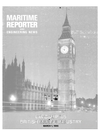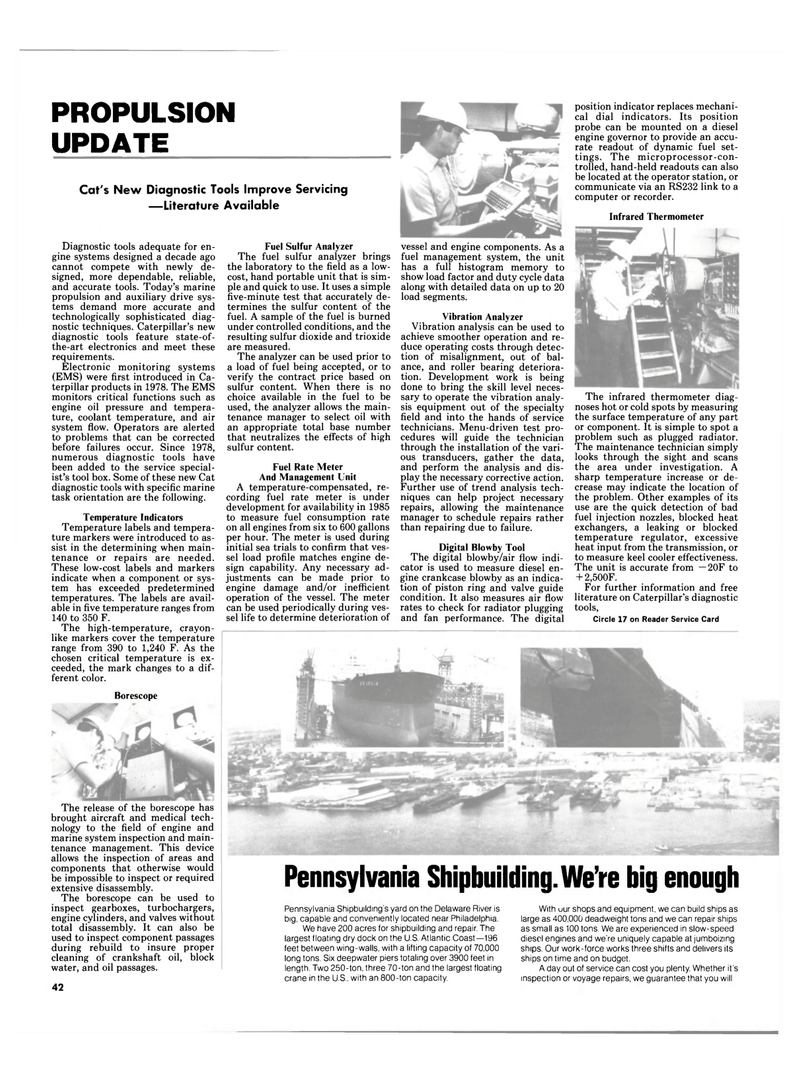
Page 40: of Maritime Reporter Magazine (March 1985)
Read this page in Pdf, Flash or Html5 edition of March 1985 Maritime Reporter Magazine
vessel and engine components. As a fuel management system, the unit has a full histogram memory to show load factor and duty cycle data along with detailed data on up to 20 load segments.
Vibration Analyzer
Vibration analysis can be used to achieve smoother operation and re- duce operating costs through detec- tion of misalignment, out of bal- ance, and roller bearing deteriora- tion. Development work is being done to bring the skill level neces- sary to operate the vibration analy- sis equipment out of the specialty field and into the hands of service technicians. Menu-driven test pro- cedures will guide the technician through the installation of the vari- ous transducers, gather the data, and perform the analysis and dis- play the necessary corrective action.
Further use of trend analysis tech- niques can help project necessary repairs, allowing the maintenance manager to schedule repairs rather than repairing due to failure.
Digital Blowby Tool
The digital blowby/air flow indi- cator is used to measure diesel en- gine crankcase blowby as an indica- tion of piston ring and valve guide condition. It also measures air flow rates to check for radiator plugging and fan performance. The digital
The release of the borescope has brought aircraft and medical tech- nology to the field of engine and marine system inspection and main- tenance management. This device allows the inspection of areas and components that otherwise would be impossible to inspect or required extensive disassembly.
The borescope can be used to inspect gearboxes, turbochargers, engine cylinders, and valves without total disassembly. It can also be used to inspect component passages during rebuild to insure proper cleaning of crankshaft oil, block water, and oil passages. 42
Pennsylvania Shipbuilding. We're big enough
Pennsylvania Shipbuilding's yard on the Delaware River is big, capable and conveniently located near Philadelphia,
We have 200 acres for shipbuilding and repair. The largest floating dry dock on the U.S. Atlantic Coast—196 feet between wing-walls, with a lifting capacity of 70,000 long tons. Six deepwater piers totaling over 3900 feet in length. Two 250-ton, three 70-ton and the largest floating crane in the U.S., with an 800-ton capacity.
With uur shops and equipment, we can build ships as large as 400,000 deadweight tons and we can repair ships as small as 100 tons. We are experienced in slow-speed diesel engines and we're uniquely capable at jumboizing ships. Our work-force works three shifts and delivers its ships on time and on budget.
A day out of service can cost you plenty. Whether it's inspection or voyage repairs, we guarantee that you will
PROPULSION
UPDATE position indicator replaces mechani- cal dial indicators. Its position probe can be mounted on a diesel engine governor to provide an accu- rate readout of dynamic fuel set- tings. The microprocessor-con- trolled, hand-held readouts can also be located at the operator station, or communicate via an RS232 link to a computer or recorder.
Infrared Thermometer
The infrared thermometer diag- noses hot or cold spots by measuring the surface temperature of any part or component. It is simple to spot a problem such as plugged radiator.
The maintenance technician simply looks through the sight and scans the area under investigation. A sharp temperature increase or de- crease may indicate the location of the problem. Other examples of its use are the quick detection of bad fuel injection nozzles, blocked heat exchangers, a leaking or blocked temperature regulator, excessive heat input from the transmission, or to measure keel cooler effectiveness.
The unit is accurate from — 20F to + 2,500F.
For further information and free literature on Caterpillar's diagnostic tools,
Circle 17 on Reader Service Card
Cat's New Diagnostic Tools Improve Servicing —Literature Available
Diagnostic tools adequate for en- gine systems designed a decade ago cannot compete with newly de- signed, more dependable, reliable, and accurate tools. Today's marine propulsion and auxiliary drive sys- tems demand more accurate and technologically sophisticated diag- nostic techniques. Caterpillar's new diagnostic tools feature state-of- the-art electronics and meet these requirements.
Electronic monitoring systems (EMS) were first introduced in Ca- terpillar products in 1978. The EMS monitors critical functions such as engine oil pressure and tempera- ture, coolant temperature, and air system flow. Operators are alerted to problems that can be corrected before failures occur. Since 1978, numerous diagnostic tools have been added to the service special- ist's tool box. Some of these new Cat diagnostic tools with specific marine task orientation are the following.
Temperature Indicators
Temperature labels and tempera- ture markers were introduced to as- sist in the determining when main- tenance or repairs are needed.
These low-cost labels and markers indicate when a component or sys- tem has exceeded predetermined temperatures. The labels are avail- able in five temperature ranges from 140 to 350 F.
The high-temperature, crayon- like markers cover the temperature range from 390 to 1,240 F. As the chosen critical temperature is ex- ceeded, the mark changes to a dif- ferent color.
Borescope
Fuel Sulfur Analyzer
The fuel sulfur analyzer brings the laboratory to the field as a low- cost, hand portable unit that is sim- ple and quick to use. It uses a simple five-minute test that accurately de- termines the sulfur content of the fuel. A sample of the fuel is burned under controlled conditions, and the resulting sulfur dioxide and trioxide are measured.
The analyzer can be used prior to a load of fuel being accepted, or to verify the contract price based on sulfur content. When there is no choice available in the fuel to be used, the analyzer allows the main- tenance manager to select oil with an appropriate total base number that neutralizes the effects of high sulfur content.
Fuel Rate Meter
And Management Unit
A temperature-compensated, re- cording fuel rate meter is under development for availability in 1985 to measure fuel consumption rate on all engines from six to 600 gallons per hour. The meter is used during initial sea trials to confirm that ves- sel load profile matches engine de- sign capability. Any necessary ad- justments can be made prior to engine damage and/or inefficient operation of the vessel. The meter can be used periodically during ves- sel life to determine deterioration of

 39
39

 41
41
